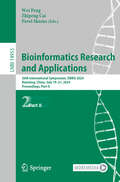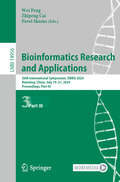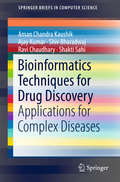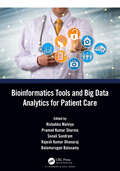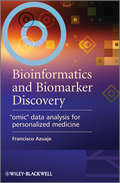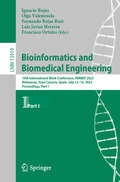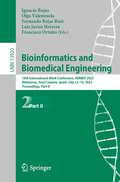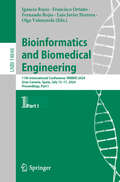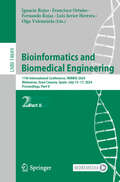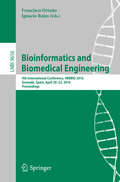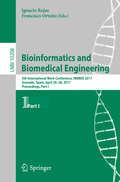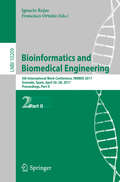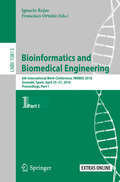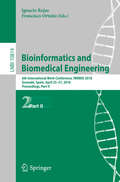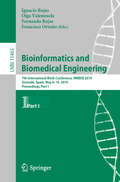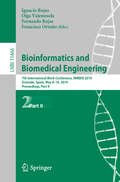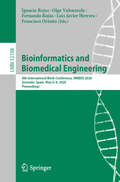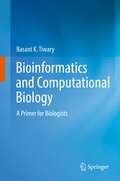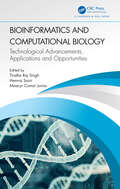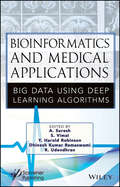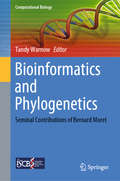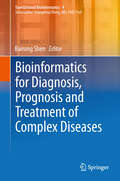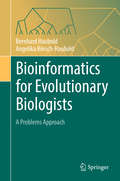- Table View
- List View
Bioinformatics Research and Applications: 20th International Symposium, ISBRA 2024, Kunming, China, July 19–21, 2024, Proceedings, Part II (Lecture Notes in Computer Science #14955)
by Pavel Skums Zhipeng Cai Wei PengThis book constitutes the refereed proceedings of the 20th International Symposium on Bioinformatics Research and Applications, ISBRA 2024, held in Kunming, China, in July 19–21, 2024. The 93 full papers included in this book were carefully reviewed and selected from 236 submissions. The symposium provides a forum for the exchange of ideas and results among researchers, developers, and practitioners working on all aspects of bioinformatics and computational biology and their applications.
Bioinformatics Research and Applications: 20th International Symposium, ISBRA 2024, Kunming, China, July 19–21, 2024, Proceedings, Part III (Lecture Notes in Computer Science #14956)
by Pavel Skums Zhipeng Cai Wei PengThis book constitutes the refereed proceedings of the 20th International Symposium on Bioinformatics Research and Applications, ISBRA 2024, held in Kunming, China, in July 19–21, 2024. The 93 full papers included in this book were carefully reviewed and selected from 236 submissions. The symposium provides a forum for the exchange of ideas and results among researchers, developers, and practitioners working on all aspects of bioinformatics and computational biology and their applications.
Bioinformatics Techniques for Drug Discovery: Applications For Complex Diseases (SpringerBriefs in Computer Science)
by Ajay Kumar Aman Chandra Kaushik Shiv Bharadwaj Ravi Chaudhary Shakti SahiThe application of bioinformatics approaches in drug design involves an interdisciplinary array of sophisticated techniques and software tools to elucidate hidden or complex biological data. This work reviews the latest bioinformatics approaches used for drug discovery. The text covers ligand-based and structure-based approaches for computer-aided drug design, 3D pharmacophore modeling, molecular dynamics simulation, the thermodynamics of ligand−receptor and ligand−enzyme association, thermodynamic characterization and optimization, and techniques for computational genomics and proteomics.
Bioinformatics Tools and Big Data Analytics for Patient Care
by Pramod Kumar Sharma Balamurugan Balusamy Rajesh Kumar Dhanaraj Rishabha Malviya Sonali SundramNowadays, raw biological data can be easily stored as databases in computers but extracting the required information is the real challenge for researchers. For this reason, bioinformatics tools perform a vital role in extracting and analyzing information from databases. Bioinformatics Tools and Big Data Analytics for Patient describes the applications of bioinformatics, data management, and computational techniques in clinical studies and drug discovery for patient care. The book gives details about the recent developments in the fields of artificial intelligence, cloud computing, and data analytics. It highlights the advances in computational techniques used to perform intelligent medical tasks. Features: • Presents recent developments in the fields of artificial intelligence, cloud computing, and data analytics for improved patient care. • Describes the applications of bioinformatics, data management, and computational techniques in clinical studies and drug discovery. • Summarizes several strategies, analyses, and optimization methods for patient healthcare. • Focuses on drug discovery and development by cloud computing and data-driven research. The targeted audience comprises academics, research scholars, healthcare professionals, hospital managers, pharmaceutical chemists, the biomedical industry, software engineers, and IT professionals.
Bioinformatics and Biomarker Discovery
by Francisco AzuajeThis book is designed to introduce biologists, clinicians and computational researchers to fundamental data analysis principles, techniques and tools for supporting the discovery of biomarkers and the implementation of diagnostic/prognostic systems.The focus of the book is on how fundamental statistical and data mining approaches can support biomarker discovery and evaluation, emphasising applications based on different types of "omic" data. The book also discusses design factors, requirements and techniques for disease screening, diagnostic and prognostic applications.Readers are provided with the knowledge needed to assess the requirements, computational approaches and outputs in disease biomarker research. Commentaries from guest experts are also included, containing detailed discussions of methodologies and applications based on specific types of "omic" data, as well as their integration. Covers the main range of data sources currently used for biomarker discoveryCovers the main range of data sources currently used for biomarker discoveryPuts emphasis on concepts, design principles and methodologies that can be extended or tailored to more specific applicationsOffers principles and methods for assessing the bioinformatic/biostatistic limitations, strengths and challenges in biomarker discovery studiesDiscusses systems biology approaches and applicationsIncludes expert chapter commentaries to further discuss relevance of techniques, summarize biological/clinical implications and provide alternative interpretations
Bioinformatics and Biomedical Engineering: 10th International Work-Conference, IWBBIO 2023, Meloneras, Gran Canaria, Spain, July 12–14, 2023, Proceedings, Part I (Lecture Notes in Computer Science #13919)
by Ignacio Rojas Francisco Ortuño Olga Valenzuela Luis Javier Herrera Fernando Rojas RuizThis volume constitutes the proceedings of the 10th International Work-Conference on IWBBIO 2023, held in Meloneras, Gran Canaria, Spain, during July 12-14, 2022. The total of 79 papers presented in the proceedings, was carefully reviewed and selected from 209 submissions. The papers cove the latest ideas and realizations in the foundations, theory, models, and applications for interdisciplinary and multidisciplinary research encompassing disciplines of computer science, mathematics, statistics, biology, bioinformatics, and biomedicine.
Bioinformatics and Biomedical Engineering: 10th International Work-Conference, IWBBIO 2023, Meloneras, Gran Canaria, Spain, July 12–14, 2023, Proceedings, Part II (Lecture Notes in Computer Science #13920)
by Ignacio Rojas Francisco Ortuño Olga Valenzuela Luis Javier Herrera Fernando Rojas RuizThis volume constitutes the proceedings of the 10th International Work-Conference on IWBBIO 2023, held in Meloneras, Gran Canaria, Spain, during July 12-14, 2022. The total of 79 papers presented in the proceedings, was carefully reviewed and selected from 209 submissions. The papers cove the latest ideas and realizations in the foundations, theory, models, and applications for interdisciplinary and multidisciplinary research encompassing disciplines of computer science, mathematics, statistics, biology, bioinformatics, and biomedicine.
Bioinformatics and Biomedical Engineering: 11th International Conference, IWBBIO 2024, Meloneras, Gran Canaria, Spain, July 15–17, 2024, Proceedings, Part I (Lecture Notes in Computer Science #14848)
by Ignacio Rojas Francisco Ortuño Olga Valenzuela Fernando Rojas Luis Javier HerreraThis volume constitutes the proceedings of the 11th International Work-Conference on IWBBIO 2023, held in Gran Canaria, Spain, during July 15-17, 2022. The 54 full papers were carefully reviewed and selected from 148 submissions. They were organized in the following topical sections: Biomarker Identification, Biomedical Engineering, Biomedical Signal Analysis, E-Health.
Bioinformatics and Biomedical Engineering: 11th International Conference, IWBBIO 2024, Meloneras, Gran Canaria, Spain, July 15–17, 2024, Proceedings, Part II (Lecture Notes in Computer Science #14849)
by Ignacio Rojas Francisco Ortuño Olga Valenzuela Fernando Rojas Luis Javier HerreraThis volume constitutes the proceedings of the 11th International Work-Conference on IWBBIO 2023, held in Meloneras, Gran Canaria, Spain, during July 15-17, 2022. The 54 full papers were carefully reviewed and selected from 148 submissions. They were organized in the following topical sections: Healthcare and Diseases, Machine Learning in Bioinformatics, New Advances in Deep Learning in Bioinformatics and Biomedicine, Novel Methodologies and Applications in Bioinformatics and Biomedicine.
Bioinformatics and Biomedical Engineering: 4th International Conference, IWBBIO 2016, Granada, Spain, April 20-22, 2016, Proceedings (Lecture Notes in Computer Science #9656)
by Ignacio Rojas Francisco OrtuñoThis book constitutes the refereed proceedings of the 4th International Conference on Bioinformatics and Biomedical Engineering, IWBBIO 2016, held in Granada, Spain, in April 2016. The 69 papers presented were carefully reviewed and selected from 286 submissions. The scope of the conference spans the following areas: bioinformatics for healthcare and diseases; biomedical image analysis; biomedical signal analysis; computational systems for modeling biological processes; eHealth; tools for next generation sequencing data analysis; assistive technology for people with neuromotor disorders; fundamentals of biological dynamics and maximization of the information extraction from the experiments in the biological systems; high performance computing in bioinformatics, computational biology and computational chemistry; human behavior monitoring, analysis and understanding; pattern recognition and machine learning in the -omics sciences; and resources for bioinformatics.
Bioinformatics and Biomedical Engineering: 5th International Work-Conference, IWBBIO 2017, Granada, Spain, April 26–28, 2017, Proceedings, Part I (Lecture Notes in Computer Science #10208)
by Ignacio Rojas and Francisco OrtuñoThis two volume set LNBI 10208 and LNBI 10209 constitutes the proceedings of the 5th International Work-Conference on Bioinformatics and Biomedical Engineering, IWBBIO 2017, held in Granada, Spain, in April 2017. The 122 papers presented were carefully reviewed and selected from 309 submissions. The scope of the conference spans the following areas: advances in computational intelligence for critical care; bioinformatics for healthcare and diseases; biomedical engineering; biomedical image analysis; biomedical signal analysis; biomedicine; challenges representing large-scale biological data; computational genomics; computational proteomics; computational systems for modeling biological processes; data driven biology - new tools, techniques and resources; eHealth; high-throughput bioinformatic tools for genomics; oncological big data and new mathematical tools; smart sensor and sensor-network architectures; time lapse experiments and multivariate biostatistics.
Bioinformatics and Biomedical Engineering: 5th International Work-Conference, IWBBIO 2017, Granada, Spain, April 26–28, 2017, Proceedings, Part II (Lecture Notes in Computer Science #10209)
by Ignacio Rojas and Francisco OrtuñoThis two volume set LNBI 10208 and LNBI 10209 constitutes the proceedings of the 5th International Work-Conference on Bioinformatics and Biomedical Engineering, IWBBIO 2017, held in Granada, Spain, in April 2017. The 122 papers presented were carefully reviewed and selected from 309 submissions. The scope of the conference spans the following areas: advances in computational intelligence for critical care; bioinformatics for healthcare and diseases; biomedical engineering; biomedical image analysis; biomedical signal analysis; biomedicine; challenges representing large-scale biological data; computational genomics; computational proteomics; computational systems for modeling biological processes; data driven biology - new tools, techniques and resources; eHealth; high-throughput bioinformatic tools for genomics; oncological big data and new mathematical tools; smart sensor and sensor-network architectures; time lapse experiments and multivariate biostatistics.
Bioinformatics and Biomedical Engineering: 6th International Work-Conference, IWBBIO 2018, Granada, Spain, April 25–27, 2018, Proceedings, Part I (Lecture Notes in Computer Science #10813)
by Ignacio Rojas Francisco OrtuñoThis two-volume set LNBI 10813 and LNBI 10814 constitutes the proceedings of the 6th International Work-Conference on Bioinformatics and Biomedical Engineering, IWBBIO 2018, held in Granada, Spain, in April 2018.The 88 regular papers presented were carefully reviewed and selected from 273 submissions. The scope of the conference spans the following areas: bioinformatics for healthcare and diseases; bioinformatics tools to integrate omics dataset and address biological question; challenges and advances in measurement and self-parametrization of complex biological systems; computational genomics; computational proteomics; computational systems for modelling biological processes; drug delivery system design aided by mathematical modelling and experiments; generation, management and biological insights from big data; high-throughput bioinformatic tools for medical genomics; next generation sequencing and sequence analysis; interpretable models in biomedicine and bioinformatics; little-big data. Reducing the complexity and facing uncertainty of highly underdetermined phenotype prediction problems; biomedical engineering; biomedical image analysis; biomedical signal analysis; challenges in smart and wearable sensor design for mobile health; and healthcare and diseases.
Bioinformatics and Biomedical Engineering: 6th International Work-Conference, IWBBIO 2018, Granada, Spain, April 25–27, 2018, Proceedings, Part II (Lecture Notes in Computer Science #10814)
by Ignacio Rojas Francisco OrtuñoThis two volume set LNBI 10813 and LNBI 10814 constitutes the proceedings of the 6th International Work-Conference on Bioinformatics and Biomedical Engineering, IWBBIO 2018, held in Granada, Spain, in April 2018.The 88 regular papers presented were carefully reviewed and selected from 273 submissions. The scope of the conference spans the following areas: bioinformatics for healthcare and diseases; bioinformatics tools to integrate omics dataset and address biological question; challenges and advances in measurement and self-parametrization of complex biological systems; computational genomics; computational proteomics; computational systems for modelling biological processes; drug delivery system design aided by mathematical modelling and experiments; generation, management and biological insights from big data; high-throughput bioinformatic tools for medical genomics; next generation sequencing and sequence analysis; interpretable models in biomedicine and bioinformatics; little-big data. Reducing the complexity and facing uncertainty of highly underdetermined phenotype prediction problems; biomedical engineering; biomedical image analysis; biomedical signal analysis; challenges in smart and wearable sensor design for mobile health; and healthcare and diseases.
Bioinformatics and Biomedical Engineering: 7th International Work-Conference, IWBBIO 2019, Granada, Spain, May 8-10, 2019, Proceedings, Part I (Lecture Notes in Computer Science #11465)
by Ignacio Rojas Francisco Ortuño Olga Valenzuela Fernando RojasThe two-volume set LNBI 11465 and LNBI 11466 constitutes the proceedings of the 7th International Work-Conference on Bioinformatics and Biomedical Engineering, IWBBIO 2019, held in Granada, Spain, in May 2019. The total of 97 papers presented in the proceedings, was carefully reviewed and selected from 301 submissions. The papers are organized in topical sections as follows: Part I: High-throughput genomics: bioinformatics tools and medical applications; omics data acquisition, processing, and analysis; bioinformatics approaches for analyzing cancer sequencing data; next generation sequencing and sequence analysis; structural bioinformatics and function; telemedicine for smart homes and remote monitoring; clustering and analysis of biological sequences with optimization algorithms; and computational approaches for drug repurposing and personalized medicine. Part II: Bioinformatics for healthcare and diseases; computational genomics/proteomics; computational systems for modelling biological processes; biomedical engineering; biomedical image analysis; and biomedicine and e-health.
Bioinformatics and Biomedical Engineering: 7th International Work-Conference, IWBBIO 2019, Granada, Spain, May 8-10, 2019, Proceedings, Part II (Lecture Notes in Computer Science #11466)
by Ignacio Rojas Francisco Ortuño Olga Valenzuela Fernando RojasThe two-volume set LNBI 11465 and LNBI 11466 constitutes the proceedings of the 7th International Work-Conference on Bioinformatics and Biomedical Engineering, IWBBIO 2019, held in Granada, Spain, in May 2019. The total of 97 papers presented in the proceedings, was carefully reviewed and selected from 301 submissions. The papers are organized in topical sections as follows: Part I: High-throughput genomics: bioinformatics tools and medical applications; omics data acquisition, processing, and analysis; bioinformatics approaches for analyzing cancer sequencing data; next generation sequencing and sequence analysis; structural bioinformatics and function; telemedicine for smart homes and remote monitoring; clustering and analysis of biological sequences with optimization algorithms; and computational approaches for drug repurposing and personalized medicine. Part II: Bioinformatics for healthcare and diseases; computational genomics/proteomics; computational systems for modelling biological processes; biomedical engineering; biomedical image analysis; and biomedicine and e-health.
Bioinformatics and Biomedical Engineering: 8th International Work-Conference, IWBBIO 2020, Granada, Spain, May 6–8, 2020, Proceedings (Lecture Notes in Computer Science #12108)
by Ignacio Rojas Francisco Ortuño Olga Valenzuela Fernando Rojas Luis Javier HerreraThis volume constitutes the proceedings of the 8th International Work-Conference on IWBBIO 2020, held in Granada, Spain, in May 2020. The total of 73papers presented in the proceedings, was carefully reviewed and selected from 241 submissions. The papers are organized in topical sections as follows: Biomarker Identification; Biomedical Engineering; Biomedical Signal Analysis; Bio-Nanotechnology; Computational Approaches for Drug Design and Personalized Medicine; Computational Proteomics and Protein-Protein Interactions; Data Mining from UV/VIS/NIR Imaging and Spectrophotometry; E-Health Technology, Services and Applications; Evolving Towards Digital Twins in Healthcare (EDITH); High Performance in Bioinformatics; High-Throughput Genomics: Bioinformatic Tools and Medical Applications; Machine Learning in Bioinformatics; Medical Image Processing; Simulation and Visualization of Biological Systems.
Bioinformatics and Computational Biology in Drug Discovery and Development
by William T. LogingComputational biology drives discovery through its use of high-throughput informatics approaches. This book provides a road map of the current drug development process and how computational biology approaches play a critical role across the entire drug discovery pipeline. Through the use of previously unpublished, real-life case studies the impact of a range of computational approaches are discussed at various phases of the pipeline. Additionally, a focus section provides innovative visualisation approaches, from both the drug discovery process as well as from other fields that utilise large datasets, recognising the increasing use of such technology. Serving the needs of early career and more experienced scientists, this up-to-date reference provides an essential introduction to the process and background of drug discovery, highlighting how computational researchers can contribute to that pipeline.
Bioinformatics and Computational Biology: A Primer for Biologists
by Basant K. TiwaryThis textbook introduces fundamental concepts of bioinformatics and computational biology to the students and researchers in biology, medicine, veterinary science, agriculture, and bioengineering . The respective chapters provide detailed information on biological databases, sequence alignment, molecular evolution, next-generation sequencing, systems biology, and statistical computing using R. The book also presents a case-based discussion on clinical, veterinary, agricultural bioinformatics, and computational bioengineering for application-based learning in the respective fields. Further, it offers readers guidance on reconstructing and analysing biological networks and highlights computational methods used in systems medicine and genome-wide association mapping of diseases. Given its scope, this textbook offers an essential introductory book on bioinformatics and computational biology for undergraduate and graduate students in the life sciences, botany, zoology, physiology, biotechnology, bioinformatics, and genomic science as well as systems biology, bioengineering and the agricultural, and veterinary sciences.
Bioinformatics and Computational Biology: Technological Advancements, Applications and Opportunities
by Hemraj Saini Tiratha Raj Singh Moacyr Comar JuniorBioinformatics and Computational Biology: Technological Advancements, Applications and Opportunities is an invaluable resource for general and applied researchers who analyze biological data that is generated, at an unprecedented rate, at the global level. After careful evaluation of the requirements for current trends in bioinformatics and computational biology, it is anticipated that the book will provide an insightful resource to the academic and scientific community. Through a myriad of computational resources, algorithms, and methods, it equips readers with the confidence to both analyze biological data and estimate predictions.The book offers comprehensive coverage of the most essential and emerging topics: Cloud-based monitoring of bioinformatics multivariate data with cloud platforms Machine learning and deep learning in bioinformatics Quantum machine learning for biological applications Integrating machine learning strategies with multiomics to augment prognosis in chronic diseases Biomedical engineering Next generation sequencing techniques and applications Computational systems biology and molecular evolution While other books may touch on some of the same issues and nuances of biological data analysis, they neglect to feature bioinformatics and computational biology exclusively, and as exhaustively. This book's abundance of several subtopics related to almost all of the regulatory activities of biomolecules from where real data is being generated brings an added dimension.
Bioinformatics and Medical Applications: Big Data Using Deep Learning Algorithms
by A. Suresh Y. Harold Robinson R. Udendhran S. Vimal Dhinesh Kumar RamaswamiBIOINFORMATICS AND MEDICAL APPLICATIONS The main topics addressed in this book are big data analytics problems in bioinformatics research such as microarray data analysis, sequence analysis, genomics-based analytics, disease network analysis, techniques for big data analytics, and health information technology. Bioinformatics and Medical Applications: Big Data Using Deep Learning Algorithms analyses massive biological datasets using computational approaches and the latest cutting-edge technologies to capture and interpret biological data. The book delivers various bioinformatics computational methods used to identify diseases at an early stage by assembling cutting-edge resources into a single collection designed to enlighten the reader on topics focusing on computer science, mathematics, and biology. In modern biology and medicine, bioinformatics is critical for data management. This book explains the bioinformatician’s important tools and examines how they are used to evaluate biological data and advance disease knowledge. The editors have curated a distinguished group of perceptive and concise chapters that presents the current state of medical treatments and systems and offers emerging solutions for a more personalized approach to healthcare. Applying deep learning techniques for data-driven solutions in health information allows automated analysis whose method can be more advantageous in supporting the problems arising from medical and health-related information. Audience The primary audience for the book includes specialists, researchers, postgraduates, designers, experts, and engineers, who are occupied with biometric research and security-related issues.
Bioinformatics and Phylogenetics: Seminal Contributions of Bernard Moret (Computational Biology #29)
by Tandy WarnowThis volume presents a compelling collection of state-of-the-art work in algorithmic computational biology, honoring the legacy of Professor Bernard M.E. Moret in this field. Reflecting the wide-ranging influences of Prof. Moret’s research, the coverage encompasses such areas as phylogenetic tree and network estimation, genome rearrangements, cancer phylogeny, species trees, divide-and-conquer strategies, and integer linear programming. Each self-contained chapter provides an introduction to a cutting-edge problem of particular computational and mathematical interest.Topics and features: addresses the challenges in developing accurate and efficient software for the NP-hard maximum likelihood phylogeny estimation problem; describes the inference of species trees, covering strategies to scale phylogeny estimation methods to large datasets, and the construction of taxonomic supertrees; discusses the inference of ultrametric distances from additive distance matrices, and the inference of ancestral genomes under genome rearrangement events; reviews different techniques for inferring evolutionary histories in cancer, from the use of chromosomal rearrangements to tumor phylogenetics approaches; examines problems in phylogenetic networks, including questions relating to discrete mathematics, and issues of statistical estimation; highlights how evolution can provide a framework within which to understand comparative and functional genomics; provides an introduction to Integer Linear Programming and its use in computational biology, including its use for solving the Traveling Salesman Problem.Offering an invaluable source of insights for computer scientists, applied mathematicians, and statisticians, this illuminating volume will also prove useful for graduate courses on computational biology and bioinformatics.
Bioinformatics for Biologists
by Pavel Pevzner Ron ShamirThe computational education of biologists is changing to prepare students for facing the complex datasets of today's life science research. In this concise textbook, the authors' fresh pedagogical approaches lead biology students from first principles towards computational thinking. A team of renowned bioinformaticians take innovative routes to introduce computational ideas in the context of real biological problems. Intuitive explanations promote deep understanding, using little mathematical formalism. Self-contained chapters show how computational procedures are developed and applied to central topics in bioinformatics and genomics, such as the genetic basis of disease, genome evolution or the tree of life concept. Using bioinformatic resources requires a basic understanding of what bioinformatics is and what it can do. Rather than just presenting tools, the authors – each a leading scientist – engage the students' problem-solving skills, preparing them to meet the computational challenges of their life science careers.
Bioinformatics for Diagnosis, Prognosis and Treatment of Complex Diseases (Translational Bioinformatics #4)
by Bairong ShenThe book introduces the bioinformatics tools, databases and strategies for the translational research, focuses on the biomarker discovery based on integrative data analysis and systems biological network reconstruction. With the coming of personal genomics era, the biomedical data will be accumulated fast and then it will become reality for the personalized and accurate diagnosis, prognosis and treatment of complex diseases. The book covers both state of the art of bioinformatics methodologies and the examples for the identification of simple or network biomarkers. In addition, bioinformatics software tools and scripts are provided to the practical application in the study of complex diseases. The present state, the future challenges and perspectives were discussed. The book is written for biologists, biomedical informatics scientists and clinicians, etc. Dr. Bairong Shen is Professor and Director of Center for Systems Biology, Soochow University; he is also Director of Taicang Center for Translational Bioinformatics.
Bioinformatics for Evolutionary Biologists: A Problems Approach
by Bernhard Haubold Angelika Börsch-HauboldThis self-contained textbook covers fundamental aspects of sequence analysis in evolutionary biology, including sequence alignment, phylogeny reconstruction, and coalescent simulation. It addresses these aspects through a series of over 400 computer problems, ranging from elementary to research level to enable learning by doing. Students solve the problems in the same computational environment used for decades in science - the UNIX command line. This is available on all three major operating systems for PCs: Microsoft Windows, Mac-OSX, and Linux. To learn using this powerful system, students analyze sample sequence data by applying generic tools, bioinformatics software, and over 40 programs specifically written for this course. The solutions for all problems are included, making the book ideal for self-study. Problems are grouped into sections headed by an introduction and a list of new concepts and programs. By using practical computing to explore evolutionary concepts and sequence data, the book enables readers to tackle their own computational problems.
